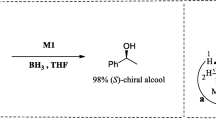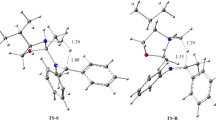Abstract
Theoretical studies on [2+2] cycloaddition step involved in the enantioselective reduction of ketones with borane catalyzed by a B-methoxyoxazaborolidine catalyst derived from pinene have been performed by means of the hybrid meta density functional theory method at MPWB1K/6-31G (d,p). The formation of the M5a(S) complexes via transition state TSa(S) was the more favorable pathway among other [2+2] cycloaddition competing steps. The explanation of the formation of O–B and N–B through two-stage one-step mechanism was allowed by means of the electron localization function topological analysis. NCI and QTAIM analysis of the two computed transition states TSa(S) and TSa(R) indicates that the difference between both in terms of stability comes mainly from the orientation of the methanediyl group inside the pinene skeleton, which implies that CH–H…O interaction found at TSa(S) is the great factor that makes it more stable than TSa(R).







Similar content being viewed by others
References
Hirao A, Itsuno S, Nakahama S, Yamazaki N (1981) J Chem Soc Chem Commun 5:315–317
Hirao A, Itsuno S, Nakahama S, Ito K (1983) J Chem Soc Chem Commun 5:469–470
Corey EJ, Bakshi RK, Shibata S (1987) J Am Chem Soc 109:5551
Corey EJ, Bakshi RK, Shibata S, Chen CP, Singh VK (1987) J Am Chem Soc 109:7925–7926
Corey EJ, Shibata S, Bakshi RK (1988) J Org Chem 53:2861
Corey EJ, Helal CJ (1998) Angew Chem Int Ed 37:1986–2012
Wallbaum S, Martens J (1992) Tetrahedron Asymmetry 3:1475–1504
Singh VK (1992) Synthesis 7:605
Deloux L, Srebnik M (1993) Chem Rev 93:763
Corey EJ, Helal CJ (1986) Angew Chem Int Ed Engl 1998:37
Masui M, Shioiri T (1997) Synlett 1:273–274
Krzemiński MP, Wojtczak A (2005) Tetrahedron Lett 46:8299–8302
Wei D, Tang M, Zhao J, Sun L, Zhang W, Zhao C, Zhang S, Wang H (2009) Tetrahedron Asymmetry 20:1020–1026
Sun L, Tang M, Wang H, Wei D, Liu L (2008) Tetrahedron Asymmetry 19:779–787
Xu J, Wei T, Zhang Q (2004) J Org Chem 69:6860–6866
Kettouche HS (2020) J Mol Model 26:27
Becke AD, Edgecombe KE (1990) J Chem Phys 92:5397–5403
Contreras-Garcίa J, Johnson ER, Keinan S, Chaudert R, Piquemal JP, Beratan DN, Yang W (2011) NCIPLOT: a program for plotting noncovalent interaction regions. J Chem Theory Comput 7:625–632
Bader RFW (1990) Atoms in molecules: a quantum theory. Oxford University Press, Oxford
Frisch MJ (2009) Gaussian 09, Revision A.02. Gaussian, Wallingford
Zhao Y, Truhlar DG (2004) J Phys Chem A 108(33):6908–6918
Hehre WJ, Radom L, Schleyer PVR, Pople JA (1986) Ab initio molecular orbital theory. Wiley, New York
Hratchian HP, Schlegel HB (2002) J Chem Phys 106:165–169
Fukui K (1970) J Phys Chem 74:4161
Parr RG, Pearson RG (1983) J Am Chem Soc 105:7512
Parr RG, Yang W (1989) Density, functional theory of atoms and molecules. Oxford University Press, New York
Parr RG, von Szentpaly L, Liu S (1922) J Am Chem Soc 1999:121
Johnson ER, Keinan S, Mori-Sanchez P, Contreras-Garcia J, Cohen J, Yang AW (2010) J Am Chem Soc 132:6498
Lane JR, Contreras-Garcia J, Piquemal JP, Miller BJ, Kjaergaard HGJ (2013) Chem Theory Comput 9:3263
Lu T, Chen F (2012) Multiwfn: a multifunctional wavefunction analyzer. J Comput Chem 33:580–592
Humphrey W, Dalke A, Schulten KVMD (1996) visual molecular dynamics. J Mol Graphics 14:33–38
Bader RFW (1990) Atoms in molecule. A quantum theory. Claredon Press, Oxford
Tachibana A (1999) Theor Chem Acc 102:188
Tachibana A, Parr RG (1992) Int J Quantum Chem 41:527
Tachibana A (1996) Int J Quantum Chem 57:423
Houk KN (1975) Acc Chem Res 8:361
Wiberg KB (1968) Tetrahedron 24:1083
Domingo LR, Emamian SR (2014) Tetrahedron 70:1267–1273
Domingo LR, Ríos-Gutiérrez M, Pérez P (2016) Tetrahedron 72:1524–1532
Savin A (2005) J Chem Sci 117:473
Eschmann C, Lijuan S, Schreiner PR (2021) Angew Chem Int Ed 60:4823–4832
Ríos-Gutiérrez M, Nasri L, Khorief Nacereddine A, Djerourou A, Domingo LR (2018) J Phys Org Chem 31:e3830
Bianchi R, Gervasio G, Marabello D (2000) Inorg Chem 39:2360–2366
Espinosa E, Alkorta I, Elguero J, Molins E (2002) J Chem Phys 117:5529–5542
Author information
Authors and Affiliations
Corresponding author
Additional information
Publisher's Note
Springer Nature remains neutral with regard to jurisdictional claims in published maps and institutional affiliations.
Supplementary Information
Below is the link to the electronic supplementary material.
Rights and permissions
About this article
Cite this article
Kettouche, H.S., Djerourou, A. Insights into the origin of selectivity for [2+2] cycloaddition step reaction involved in the mechanism of enantioselective reduction of ketones with borane catalyzed by a B-methoxy oxazaborolidine catalyst derived from (–)-β-pinene: an HMDFT and combined topological ELF, NCI and QTAIM study. Theor Chem Acc 140, 150 (2021). https://doi.org/10.1007/s00214-021-02848-4
Received:
Accepted:
Published:
DOI: https://doi.org/10.1007/s00214-021-02848-4




